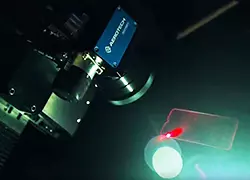5 min read
Laser Processing | Methods, Applications & Common Laser Types
 Bryan Germann
Jun 30, 2025 2:17:09 PM
Bryan Germann
Jun 30, 2025 2:17:09 PM
Laser Processing
Precision laser material processing is a cornerstone of modern advanced manufacturing, representing a collection of techniques that use highly concentrated light energy to shape and modify materials with unparalleled precision. From the production of consumer electronics to the fabrication of critical aerospace components, the use of lasers as an industrial tool has revolutionized what is possible in terms of speed, quality and complexity. The principles of laser materials processing are rooted in the laser’s unique ability to deliver a massive amount of energy to a microscopic spot, enabling a wide range of thermal interactions.
This article provides a fundamental overview of laser processing methods, the types of lasers most commonly used and the diverse applications where this technology excels. Understanding these core concepts is the first step toward harnessing the power of lasers to solve today's most demanding manufacturing challenges.
What is the laser processing method?
The laser processing method is a non-contact, thermal-based manufacturing technique. It works by directing a highly focused, high-energy laser beam onto a workpiece. The material absorbs the light energy, which is instantly converted into intense heat in a very localized area. This rapid heating causes the material to melt, vaporize, or undergo a change in its microstructure.
Unlike mechanical processes that rely on physical force, the laser processing method uses light as its "tool." This eliminates issues of tool wear and mechanical stress on the part, making it ideal for processing delicate or brittle materials. The entire process is controlled by a computer, which directs a motion system to move the beam relative to the workpiece, allowing for the creation of incredibly complex and precise features simply by changing a digital design file.
What are the three types of materials processing?
While there are many specific techniques, laser-based materials processing can be broadly grouped into three main categories based on the nature of the laser-material interaction:
-
Material Removal: This is the largest and most common category. It includes processes where the laser's energy is used to remove material from the workpiece.
-
Cutting: The laser beam melts and vaporizes material along a continuous path to separate a part from a larger sheet or to create a profile.
-
Drilling: The laser creates holes by firing one or more pulses at a specific point, rapidly vaporizing the material.
- Ablation and Micromachining: This involves the precise, layer-by-layer of material to create fine features, textures or patterns on a surface, often with minimal thermal damage to the surrounding area.
-
-
Material Joining: This category involves using the laser to join two or more separate pieces of material together.
-
Welding: The laser beam melts the edges of the components, which then fuse together as they cool and solidify, creating a strong, narrow, and deep weld.
-
Soldering and Brazing: The laser is used as a precise heat source to melt a filler material to join components without melting the base materials themselves.
-
-
Material Modification: In these processes, the laser alters the properties of a material's surface without removing or joining it.
-
Surface Heat Treatment: This includes transformation hardening, where the laser rapidly heats and cools the surface of a metal like steel to increase its hardness and wear resistance.
-
Cladding and Alloying: The laser is used to melt a powdered material onto the surface of a substrate, creating a protective coating or a new surface alloy with desirable properties.
-
Marking: The laser creates a permanent, high-contrast mark on a surface through localized melting, discoloration or shallow engraving for identification and traceability.
-
What are the applications of lasers in material processing?
The applications of lasers in material processing are incredibly diverse, touching nearly every sector of manufacturing. This is due to the technology's inherent flexibility, precision and ability to work with a vast range of materials. Key application areas include:
-
Industrial and General Manufacturing: Lasers are a staple in job shops and factories for cutting sheet metal, welding components and marking parts for automotive, aerospace and industrial equipment.
-
Electronics: The precision of lasers is essential for manufacturing modern electronics. Applications include cutting flexible circuits, drilling microvias in PCBs, dicing silicon wafers and scribing glass for display panels.
-
Medical Devices: Lasers are used to fabricate life-saving devices with extreme precision, such as cutting cardiovascular stents, welding pacemaker enclosures and drilling ports in catheters. The non-contact nature of the process ensures a clean, sterile result.
-
Aerospace: In aerospace, lasers are used to drill thousands of tiny cooling holes in turbine blades and engine components, weld lightweight structures and clad parts with wear-resistant coatings.
-
Semiconductors: Advanced semiconductor packaging relies on lasers for cutting wafers, drilling through-glass vias (TGVs) and performing other micro-scale fabrication steps. The field of ultrafast laser processing of materials from science to industry has been particularly impactful here, enabling new levels of precision.
What is the most common laser material processing application?
While the applications for laser processing are broad, laser cutting is widely considered the most common and mature application in terms of the number of systems installed and its prevalence across industries.
While the applications for laser processing are broad, laser cutting is widely considered the most common and mature application in terms of the number of systems installed and its prevalence across industries.
From small job shops to massive automotive plants, laser cutting machines are a workhorse technology for profiling parts from sheet metal. Its speed, flexibility and high-quality finish have made it a dominant technology in this space. Following closely behind cutting are laser marking and welding, which are also ubiquitous across manufacturing for part identification and assembly, respectively. While other applications like drilling may involve a higher volume of individual features (billions of microvias, for instance), the sheer number of systems dedicated to cutting makes it the most widespread laser processing method.
What is the type of laser used most widely in industrial materials processing applications?
Historically, the CO₂ laser has been one of the most widely used lasers in industrial materials processing, particularly for cutting thick-section metals, non-metals and organic materials. Its powerful beam and long wavelength (10.6 µm) made it a versatile and cost-effective workhorse for many years.
However, in the last decade, the fiber laser has rapidly become the dominant and most widely used type for a huge segment of industrial applications, especially metal cutting and welding. Fiber lasers offer several key advantages:
-
Higher Efficiency: They are significantly more energy-efficient than CO₂ lasers, leading to lower operating costs.
-
Excellent Beam Quality: Fiber lasers produce a high-quality beam that can be focused to a very small and intense spot, enabling faster cutting speeds and the ability to process reflective materials like copper and brass more effectively.
-
Low Maintenance: Their solid-state design with no moving parts or consumable gases results in high reliability and minimal maintenance.
-
Fiber Delivery: The beam can be easily delivered through a flexible optical fiber, simplifying integration into robotic and multi-axis motion systems.
While CO₂ and other lasers like Nd:YAG and ultrafast lasers still have critical roles in specific niches, the fiber laser is now the most prevalent choice for a majority of new industrial metal processing applications.
How do lasers cut through materials?
Lasers cut through materials by using a highly focused beam of light to deliver an intense concentration of energy to a small point. This energy is absorbed by the material, causing its temperature to rise dramatically and instantaneously. This rapid heating leads to a localized melting and vaporization of the material.
To create a continuous cut, this process is combined with two other crucial elements:
-
Assist Gas: A high-pressure jet of gas is directed into the cut zone through a nozzle that surrounds the laser beam. This gas flow serves to forcefully eject, or blow away, the molten and vaporized material from the cut. This clears the path for the laser beam to penetrate deeper into the material and continue the cutting process. The type of gas used (e.g., oxygen for steel, nitrogen for stainless steel) can also influence the cut quality and speed.
-
Relative Motion: A precision motion control system moves either the laser cutting head over a stationary workpiece or moves the workpiece under a fixed beam. This motion guides the laser beam along a programmed path (a vector), effectively tracing the shape of the part to be cut. The speed of this motion must be carefully synchronized with the laser power and material thickness to ensure a clean, consistent cut.
By perfectly coordinating these three elements—the focused laser energy, the assist gas jet and the precise motion path—a laser cutting system can sever materials with exceptional accuracy and quality.
1 min read
How Does Laser Processing Work? | Methods, Machines & Material Interaction
How does laser processing work? Laser processing is a sophisticated manufacturing technique that uses a focused beam of light to precisely alter...
What Is the Manufacturing Process of Laser Cutting? | Steps & Limitations
What is the manufacturing process of laser cutting? The manufacturing process of laser cutting is a highly advanced method that uses a focused beam...

